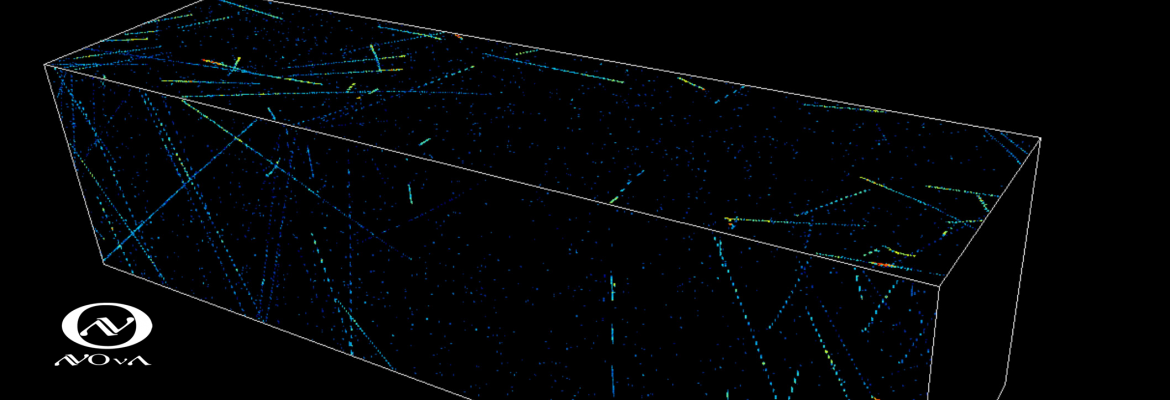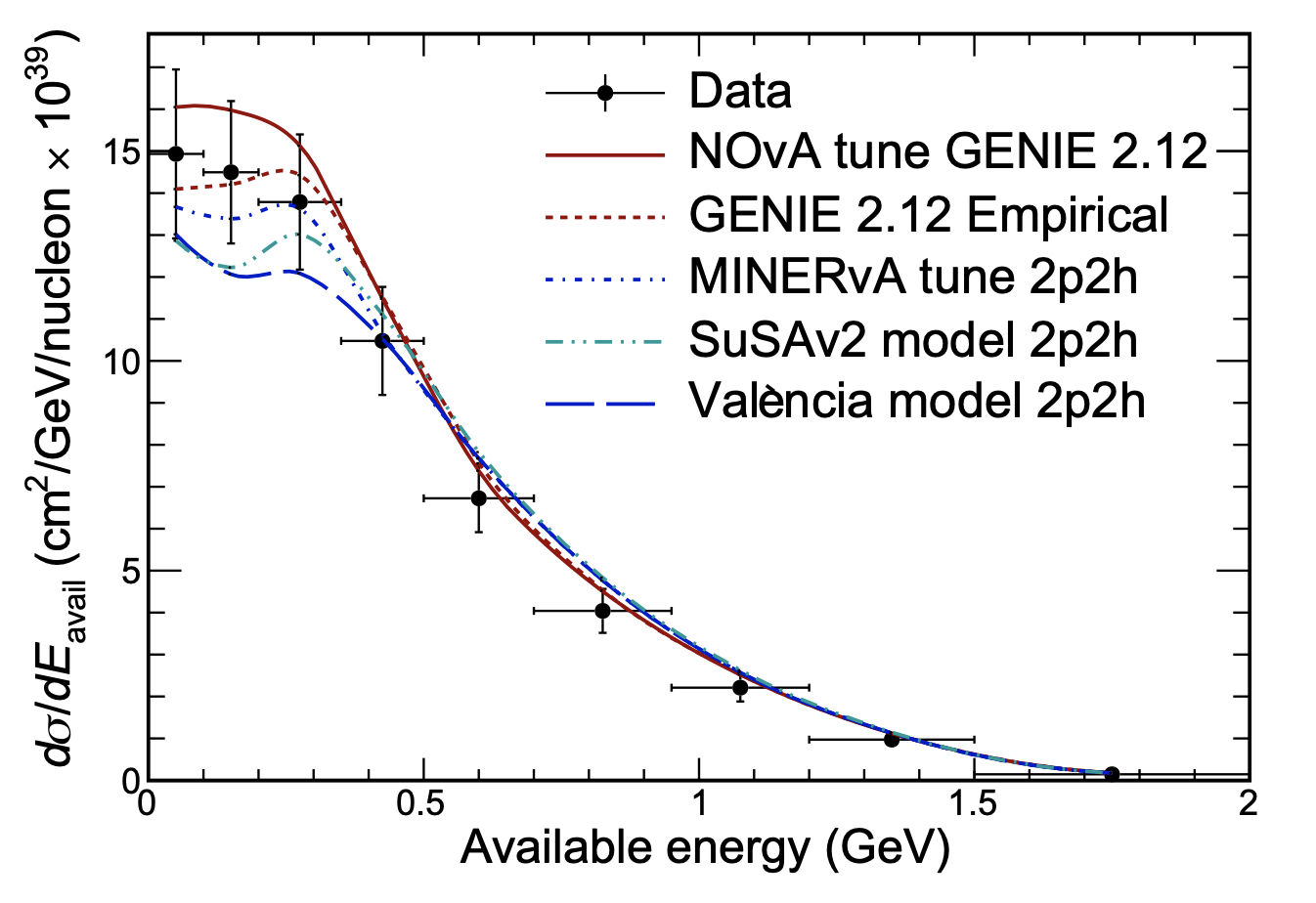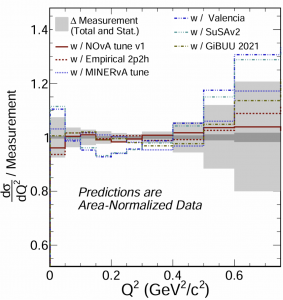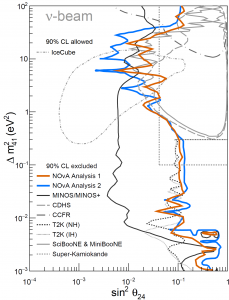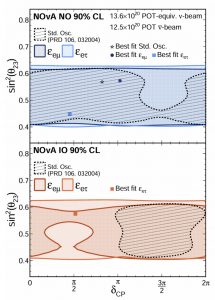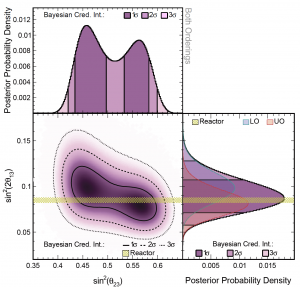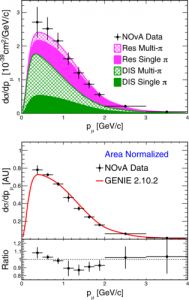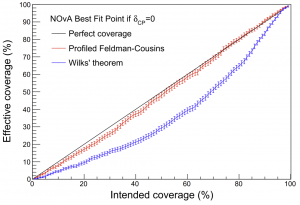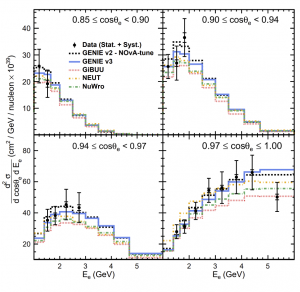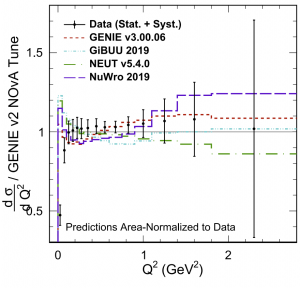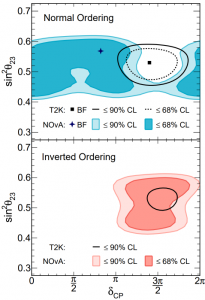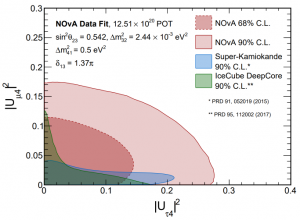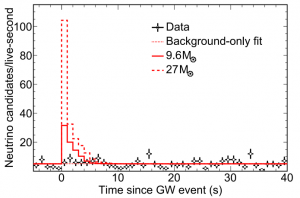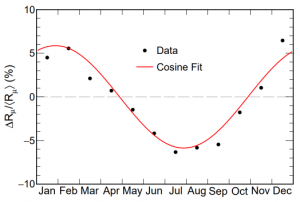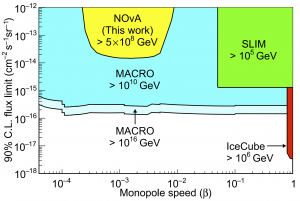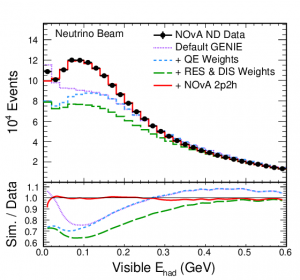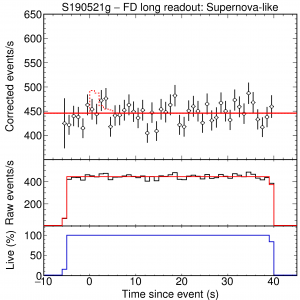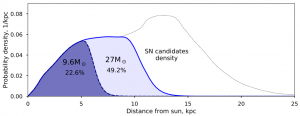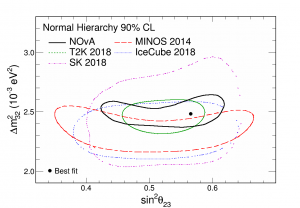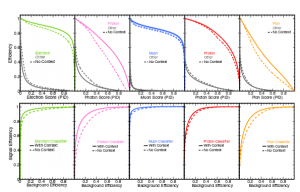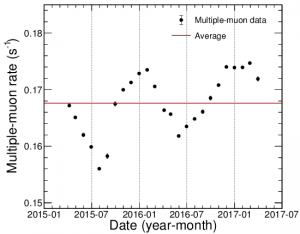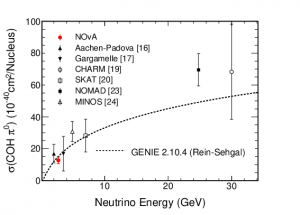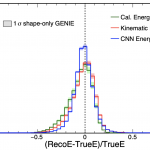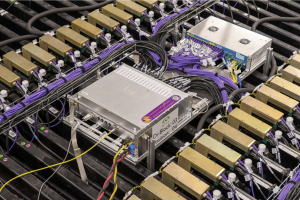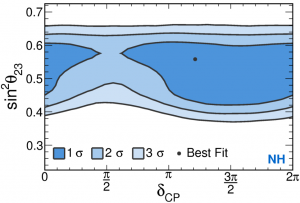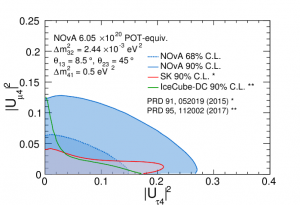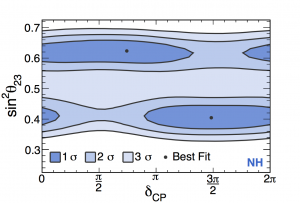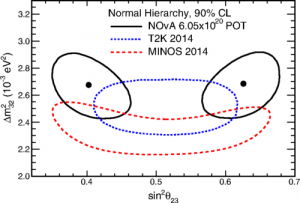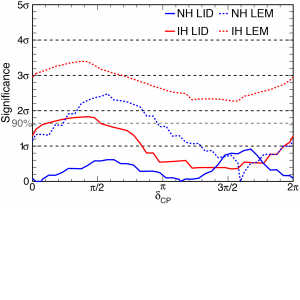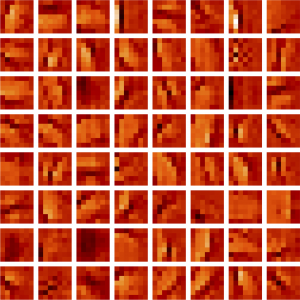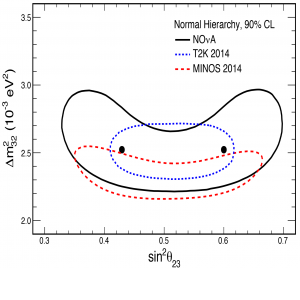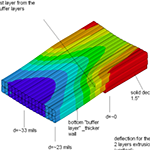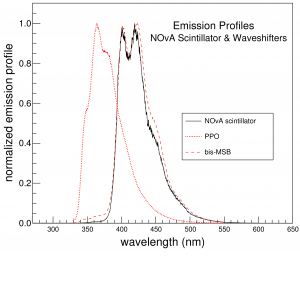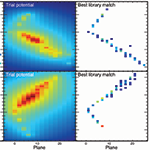as of writing March 2025
Measurement of d2σ/d|q|dEavail in charged current neutrino-nucleus interactions at <Ev> = 1.86 GeV using the NOvA Near Detector
FERMILAB-PUB-24-0571-PPD
October 2024
Double- and single-differential cross sections for inclusive charged-current νµ-nucleus scattering are reported for the kinematic domain 0 to 2 GeV/c in three-momentum transfer and 0 to 2 GeV in available energy, at a mean νµ energy of 1.86 GeV. The measurements are based on an estimated 995,760 νµ charged-current (CC) interactions in the scintillator medium of the NOvA Near Detector. The subdomain populated by 2-particle-2-hole reactions is identified by the cross-section excess relative to predictions for νµ-nucleus scattering that are constrained by a data control sample. Models for 2-particle-2-hole processes are rated by χ2 comparisons of the predicted-versus-measured νµ CC inclusive cross section over the full phase space and in the restricted subdomain. Shortfalls are observed in neutrino generator predictions obtained using the theory-based València and SuSAv2 2p2h models.
Measurement of the double-differential cross section of muon-neutrino charged-current interactions with low hadronic energy in the NOvA Near Detector
FERMILAB-PUB-24-0654-PPD
October 2024
The NOvA collaboration reports cross-section measurements for νμ charged-current interactions with low hadronic energy (maximum kinetic energy of 250 MeV for protons and 175 MeV for pions) in the NOvA Near Detector. The results are presented as a double-differential cross section as a function of the direct observables of the final-state muon kinematics. Results are also presented as a single-differential cross section as a function of the derived square of the four-momentum transfer, Q2, and as a function of the derived neutrino energy. The data correspond to an accumulated 8.09×1020 protons-on-target (POT) in the neutrino mode of the NuMI beam, with a narrow band of neutrino energies peaked at 1.8 GeV. The analysis provides a sample of neutrino-nucleus interactions with an enhanced fraction of quasi-elastic and two-particle-two-hole (2p2h) interactions. This enhancement allows quantitative comparisons with various nuclear models. We find strong disagreement between data and theory-based models in various regions of the muon kinematic phase space, especially in the forward muon direction.
Dual-Baseline Search for Active-to-Sterile Neutrino Oscillations in NOvA
FERMILAB-PUB-24-0555-PPD
September 2024
We report a search for neutrino oscillations to sterile neutrinos under a model with three active and one sterile neutrinos (3+1 model). This analysis uses the NOvA detectors exposed to the NuMI beam, running in neutrino mode. The data exposure, 13.6e20 protons on target, doubles that previously analyzed by NOvA, and the analysis is the first to use νμ charged-current interactions in conjunction with neutral-current interactions. Neutrino samples in the Near and Far detectors are fitted simultaneously, enabling the search to be carried out over a Δm412 range extending 2 (3) orders of magnitude above (below) 1 eV2. NOvA finds no evidence for active-to-sterile neutrino oscillations under the 3+1 model at 90% confidence level. New limits are reported in multiple regions of parameter space, excluding some regions currently allowed by IceCube at 90% confidence level. We additionally set the most stringent limits for anomalous ντ appearance for Δm412 ≤ 3 eV2.
Search for CP-violating Neutrino Non-Standard Interactions with the NOvA Experiment
FERMILAB-PUB-24-0108-PPD
March 2024
This Letter reports a search for charge-parity (CP) symmetry violating non-standard interactions (NSI) of neutrinos with matter using the NOvA Experiment, and examines their effects on the determination of the standard oscillation parameters. Data from νμ→νμ and νμ→νe oscillation channels are used to measure the effect of the NSI parameters 𝜀𝑒𝜇 and 𝜀𝑒𝜏. With 90% C.L. the magnitudes of the NSI couplings are constrained to be ∣𝜀𝑒𝜇∣ ≲ 0.3 and ∣𝜀𝑒𝜏∣ ≲ 0.4. A degeneracy at ∣𝜀𝑒𝜏∣ ≈ 1.8 is reported, and we observe that the presence of NSI limits sensitivity to the standard CP phase 𝛿CP.
Expanding neutrino oscillation parameter measurements in NOvA using a Bayesian approach
FERMILAB-PUB-23-667-AD-CSAID-ND
November 2023
NOvA is a long-baseline neutrino oscillation experiment that measures oscillations in charged-current νμ→νμ (disappearance) and νμ→νe (appearance) channels, and their antineutrino counterparts, using neutrinos of energies around 2 GeV over a distance of 810 km. In this work we reanalyze the dataset first examined in our previous paper [Phys. Rev. D 106, 032004 (2022)] using an alternative statistical approach based on Bayesian Markov Chain Monte Carlo. We measure oscillation parameters consistent with the previous results. We also extend our inferences to include the first NOvA measurements of the reactor mixing angle θ13 and the Jarlskog invariant. We use these results to quantify the strength of our inferences about CP violation, as well as to examine the effects of constraints from short-baseline measurements of θ13 using antineutrinos from nuclear reactors when making NOvA measurements of θ23. Our long-baseline measurement of θ13 is also shown to be consistent with the reactor measurements, supporting the general applicability and robustness of the PMNS framework for neutrino oscillations.
Measurement of νμ charged-current inclusive π0 production in the NOvA near detector
FERMILAB-PUB-23-026-AD-CSAID-PPD
June 2023
Cross sections for the interaction νμA→μ–π0X with neutrino energies between 1 and 5 GeV are measured using a sample of 165,000 selected events collected in the NOvA experiment’s near detector, a hydrocarbon-based detector exposed to the Neutrinos from the Main Injector beam at the Fermi National Accelerator Laboratory. Results are presented as a flux-averaged total cross section and as differential cross sections in the momenta and angles of the outgoing muon and π0, the total four-momentum transfer, and the invariant mass of the hadronic system. Comparisons are made with predictions from a reference version of the genie neutrino interaction generator. The measured total cross section of (3.57 ± 0.44) ×10−39 cm2 is 7.5% higher than the genie prediction, but is consistent within experimental errors.
Monte Carlo method for constructing confidence intervals with unconstrained and constrained nuisance parameters in the NOvA experiment
FERMILAB-PUB-22-476-ND
July 2022
Measuring observables to constrain models using maximum-likelihood estimation is fundamental to many physics experiments. Wilks’ theorem provides a simple way to construct confidence intervals on model parameters, but it only applies under certain conditions. These conditions, such as nested hypotheses and unbounded parameters, are often violated in neutrino oscillation measurements and other experimental scenarios. Monte Carlo methods can address these issues, albeit at increased computational cost. In the presence of nuisance parameters, however, the best way to implement a Monte Carlo method is ambiguous. This paper documents the method selected by the NOvA experiment, the profile construction. It presents the toy studies that informed the choice of method, details of its implementation, and tests performed to validate it. It also includes some practical considerations which may be of use to others choosing to use the profile construction.
Measurement of the νe−Nucleus Charged-Current Double-Differential Cross Section at ⟨Ev⟩ = 2.4 GeV using NOvA
FERMILAB-PUB-22-446-ND
July 2022
The inclusive electron neutrino charged-current cross section is measured in the NOvA near detector using 8.02×1020 protons-on-target (POT) in the NuMI beam. The sample of GeV electron neutrino interactions is the largest analyzed to date and is limited by ≃ 17% systematic rather than the ≃ 7.4% statistical uncertainties. The double-differential cross section in final-state electron energy and angle is presented for the first time, together with the single-differential dependence on Q2 (squared four-momentum transfer) and energy, in the range 1 GeV ≤ Ev < 6 GeV. Detailed comparisons are made to the predictions of the GENIE, GiBUU, NEUT, and NuWro neutrino event generators. The data do not strongly favor a model over the others consistently across all three cross sections measured, though some models have especially good or poor agreement in the single differential cross section vs.
Q2.
Measurement of the Double-Differential Muon-neutrino Charged-Current Inclusive Cross Section in the NOvA Near Detector
FERMILAB-PUB-21-455-ND-PPD-SCD
September 2021
We report cross-section measurements of the final-state muon kinematics for νμ charged-current interactions in the NOvA near detector using an accumulated 8.09×1020 protons-on-target (POT) in the NuMI beam. We present the results as a double-differential cross section in the observed outgoing muon energy and angle, as well as single-differential cross sections in the derived neutrino energy, Ev, and square of the four-momentum transfer, Q2. We compare the results to inclusive cross-section predictions from various neutrino event generators via χ2 calculations using a covariance matrix that accounts for bin-to-bin correlations of systematic uncertainties. These comparisons show a clear discrepancy between the data and each of the tested predictions at forward muon angle and low Q2, indicating a missing suppression of the cross section in current neutrino-nucleus scattering models.
Improved Measurement of Neutrino Oscillation Parameters by the NOvA Experiment
FERMILAB-PUB-21-373-ND
August 2021
We present new νμ→νe, νμ→νμ, νμ→νe, and νμ→νμ oscillation measurements by the NOvA experiment, with a 50% increase in neutrino-mode beam exposure over the previously reported results. The additional data, combined with previously published neutrino and antineutrino data, are all analyzed using improved techniques and simulations. A joint fit to the νe, νμ, νe, and νμ candidate samples within the 3-flavor neutrino oscillation framework continues to yield a best-fit point in the normal mass ordering and the upper octant of the θ23 mixing angle, with Δm232 = (2.41±0.07)×10-3 eV2 and sin2θ23=0.57+0.03−0.04. The data disfavor combinations of oscillation parameters that give rise to a large asymmetry in the rates of νe and νe appearance. This includes values of the CP-violating phase in the vicinity of δCP=π/2 which are excluded by 3σ for the inverted mass ordering, and values around δCP=3π/2 in the normal ordering which are disfavored at 2σ confidence.
Search for active-sterile antineutrino mixing using neutral-current interactions with the NOvA experiment
FERMILAB-PUB-21-271-ND
June 2021
This Letter reports results from the first long-baseline search for sterile antineutrinos mixing in an accelerator-based antineutrino-dominated beam. The rate of neutral-current interactions in the two NOvA detectors, at distances of 1 km and 810 km from the beam source, is analyzed using an exposure of 12.51×1020 protons-on-target from the NuMI beam at Fermilab running in antineutrino mode. A total of 121 of neutral-current candidates are observed at the Far Detector, compared to a prediction of 122±11(stat.)±15(syst.) assuming mixing between three active flavors. No evidence for νμ→νs oscillation is observed. Interpreting this result within a 3+1 model, constraints are placed on the mixing angles θ24< 25∘ and θ34< 32∘ at the 90% C.L. for 0.05 eV2 ≤ Δm241 ≤ 0.5 eV2, the range of mass splittings that produces no significant oscillations at the Near Detector. These are the first 3+1 confidence limits set using long-baseline accelerator antineutrinos.
Extended search for supernovalike neutrinos in NOvA coincident with LIGO/Virgo detections
FERMILAB-PUB-21-276-ND
June 2021
A search is performed for supernovalike neutrino interactions coincident with 76 gravitational wave events detected by the LIGO/Virgo Collaboration. For 40 of these events, full readout of the time around the gravitational wave is available from the NOvA Far Detector. For these events, we set limits on the fluence of the sum of all neutrino flavors of F<7(4)×1010 cm-2 at 90% C.L. assuming energy and time distributions corresponding to the Garching supernova models with masses 9.6(27) M⊙. Under the hypothesis that any given gravitational wave event was caused by a supernova, this corresponds to a distance of r > 29(50) kpc at 90% C.L. Weaker limits are set for other gravitational wave events with partial Far Detector data and/or Near Detector data.
Seasonal variation of multiple-muon cosmic ray air showers observed in the NOvA detector on the surface
FERMILAB-PUB-21-224-ND
May 2021
We report the rate of cosmic ray air showers with multiplicities exceeding 15 muon tracks recorded in the NOvA Far Detector between May 2016 and May 2018. The detector is located on the surface under an overburden of 3.6 meters water equivalent. We observe a seasonal dependence in the rate of multiple-muon showers, which varies in magnitude with multiplicity and zenith angle. During this period, the effective atmospheric temperature and surface pressure ranged between 210 K and 230 K and 940 mbar and 990 mbar, respectively; the shower rates are anticorrelated with the variation in the effective temperature. The variations are about 30% larger for the highest multiplicities than the lowest multiplicities and 20% larger for showers near the horizon than vertical showers.
Search for Slow Magnetic Monopoles with the NOvA Detector on the Surface
FERMILAB-PUB-20-472-ND
September 2020
We report a search for a magnetic monopole component of the cosmic-ray flux in a 95-day exposure of the NOvA experiment’s Far Detector, a 14 kt segmented liquid scintillator detector designed primarily to observe GeV-scale electron neutrinos. No events consistent with monopoles were observed, setting an upper limit on the flux of
2×10−14 cm−2 s−1 sr−1 at 90% C.L. for monopole speed 6×10−4 < β < 5×10−3 and mass greater than 5×108 GeV. Because of NOvA’s small overburden of 3 meters-water equivalent, this constraint covers a previously unexplored low-mass region.
Adjusting Neutrino Interaction Models and Evaluating Uncertainties using NOvA Near Detector Data
FERMILAB-PUB-20-243-ND
June 2020
The two-detector design of the NOvA neutrino oscillation experiment, in which two functionally identical detectors are exposed to an intense neutrino beam, aids in canceling leading order effects of cross-section uncertainties. However, limited knowledge of neutrino interaction cross sections still gives rise to some of the largest systematic uncertainties in current oscillation measurements. We show contemporary models of neutrino interactions to be discrepant with data from NOvA, consistent with discrepancies seen in other experiments. Adjustments to neutrino interaction models in GENIE that improve agreement with our data are presented. We also describe systematic uncertainties on these models, including uncertainties on multi-nucleon interactions from a newly developed procedure using NOvA near detector data.
Search for Multi-Messenger Signals in NOvA Coincident with LIGO/Virgo Detections
FERMILAB-PUB-20-018-ND
June 2020
Using the NOvA neutrino detectors, a broad search has been performed for any signal coincident with 28 gravitational wave events detected by the LIGO/Virgo Collaboration between September 2015 and July 2019. For all of these events, NOvA is sensitive to possible arrival of neutrinos and cosmic rays of GeV and higher energies. For five (seven) events in the NOvA Far (Near) Detector, timely public alerts from the LIGO/Virgo Collaboration allowed recording of MeV-scale events. No signal candidates were found.
Supernova neutrino detection in NOvA
FERMILAB-PUB-20-201-E
May 2020
The NOvA long-baseline neutrino experiment uses a pair of large, segmented, liquid-scintillator calorimeters to study neutrino oscillations, using GeV-scale neutrinos from the Fermilab NuMI beam. These detectors are also sensitive to the flux of neutrinos which are emitted during a core-collapse supernova through inverse beta decay interactions on carbon at energies of O(10 MeV). This signature provides a means to study the dominant mode of energy release for a core-collapse supernova occurring in our galaxy. We describe the data-driven software trigger system developed and employed by the NOvA experiment to identify and record neutrino data from nearby galactic supernovae. This technique has been used by NOvA to self-trigger on potential core-collapse supernovae in our galaxy, with an estimated sensitivity reaching out to 10 kpc distance while achieving a detection efficiency of 23% to 49% for supernovae from progenitor stars with masses of 9.6 M⊙ to 27 M⊙, respectively.
First measurement of neutrino oscillation parameters using neutrinos and antineutrinos by NOvA
FERMILAB-PUB-19-272-ND
June 2019
The NOvA experiment has made a 4.4σ-significant observation of νe appearance in a 2 GeV νμ beam at a distance of 810 km. Using 12.33×1020 protons on target delivered to the Fermilab NuMI neutrino beamline, the experiment recorded 27 νμ→νe candidates with a background of 10.3 and 102 νμ→νμ candidates. This new antineutrino data is combined with neutrino data to measure the oscillation parameters |Δm232|=2.48+0.11−0.06×10−3 eV2/c4, sin2θ23=0.56+0.04−0.03 in the normal neutrino mass hierarchy and upper octant and excludes most values near δCP=π/2 for the inverted mass hierarchy by more than 3σ. The data favor the normal neutrino mass hierarchy by 1.9σ and θ23 values in the upper octant by 1.6σ.
[ PRL ] [ arXiv ] [ inSPIRE ] [ Supplemental Data ]
Context-Enriched Identification of Particles with a Convolutional Network for Neutrino Events
FERMILAB-PUB-19-258-PPD
June 2019
Particle detectors record the interactions of subatomic particles and their passage through matter. The identification of these particles is necessary for in-depth physics analysis. While particles can be identified by their individual behavior as they travel through matter, the full context of the interaction in which they are produced can aid the classification task substantially. We have developed the first convolutional neural network for particle identification which uses context information. This is also the first implementation of a four-tower siamese-type architecture both for separation of independent inputs and inclusion of context information. The network classifies clusters of energy deposits from the NOvA neutrino detectors as electrons, muons, photons, pions, and protons with an overall efficiency and purity of 83.3% and 83.5%, respectively. We show that providing the network with context information improves performance by comparing our results with a network trained without context information.
Observation of seasonal variation of atmospheric multiple-muon events in the NOvA Near Detector
Phys. Rev. D 99, 122004
April 2019
Using two years of data from the NOvA Near Detector at Fermilab, we report a seasonal variation of cosmic ray induced multiple-muon (Nμ ≥ 2) event rates which has an opposite phase to the seasonal variation in the atmospheric temperature. The strength of the seasonal multiple-muon variation is shown to increase as a function of the muon multiplicity. However, no significant dependence of the strength of the seasonal variation of the multiple-muon variation is seen as a function of the muon zenith angle, or the spatial or angular separation between the correlated muons.
Measurement of Neutrino-Induced Neutral-Current Coherent π0 Production in the NOvA Near Detector
FERMILAB-PUB-19-047-ND
February 2019
The cross section of neutrino-induced neutral-current coherent π0 production on a carbon-dominated target is measured in the NOvA near detector. This measurement uses a narrow-band neutrino beam with the average neutrino energy of 2.7 GeV, which is of interest to the ongoing and future long-baseline neutrino oscillation experiments. The measured, flux-averaged cross section is σ = 14.0 ± 0.9 (stat.) ± 2.1 (syst.)×10−40 cm2/nucleus, consistent with model prediction. This result is the most precise measurement of neutral-current coherent π0 production in the few-GeV neutrino energy region.
Improved Energy Reconstruction in NOvA with Regression Convolutional Neural Networks
Phys. Rev. D 99 (2019) 1, 012011
January 2019
In neutrino experiments, neutrino energy reconstruction is crucial because neutrino oscillations and differential cross-sections are functions of neutrino energy. It is also challenging due to the complexity in the detector response and kinematics of final state particles. We propose a regression convolutional neural network (CNN) based method to reconstruct electron neutrino energy and electron energy in the NOvA neutrino experiment. We demonstrate that with raw detector pixel inputs, a regression CNN can reconstruct event energy even with complicated final states involving lepton and hadrons. Compared with kinematics-based energy reconstruction, this method achieves a significantly better energy resolution. The reconstructed to true energy ratio shows comparable or less dependence on true energy, hadronic energy fractions, and interaction modes. The regression CNN also shows smaller systematic uncertainties from the simulation of neutrino interactions. The proposed energy estimator provides improvements of 16% and 12% in RMS for νe CC and electron, respectively. This method can also be extended to solve other regression problems in High Energy Physics, taking over kinematics-based reconstruction tasks.
The NOvA Power Distribution System
FERMILAB-PUB-18-316-PPD
September 2018
We describe the power distribution systems and grounding schemes built for the near and far detectors of the NOvA long-baseline neutrino experiment. They are used to power the avalanche photodiodes and their thermoelectric coolers, the front-end boards that read out, digitize and time stamp the signals from the avalanche photodiodes, and the data concentrator modules used to receive and format the data from the front-end boards before sending them to a farm of computers used to build the events. The system powers 3464 readout channels in the far detector and 20,192 channels in the near detector.
New constraints on oscillation parameters from νe appearance and νμ disappearance in the NOvA experiment
FERMILAB-PUB-18-223-ND
May 2018
We present updated results from the NOvA experiment for νμ→ νμ and νμ→ νe oscillations from an exposure of 8.85×1020 protons on target, which represents an increase of 46% compared to our previous publication. The results utilize significant improvements in both the simulations and analysis of the data. A joint fit to the data for νμ disappearance and νe appearance gives the best fit point as normal mass hierarchy, Δm232 = 2.44×10-3 eV2/c4, sin2θ23 = 0.56, and δCP = 1.21π. The 68.3% confidence intervals in the normal mass hierarchy are Δm232 ∈ [2.37,2.52]×10−3eV2/c4, sin2θ23 ∈ [0.43,0.51] ∪ [0.52,0.60], and δCP ∈ [0,0.12π] ∪ [0.91π,2π]. The inverted mass hierarchy is disfavored at the 95% confidence level for all choices of the other oscillation parameters.
[ PRD ] [ arXiv ] [ inSPIRE ] [ Supplemental Data ]
Search for active-sterile neutrino mixing using neutral-current interactions in NOvA
FERMILAB-PUB-17-198-ND
June 2017
We report results from the first search for sterile neutrinos mixing with active neutrinos through a reduction in the rate of neutral-current interactions over a baseline of 810 km between the NOvA detectors. Analyzing a 14-kton detector equivalent exposure of 6.05×1020 protons-on-target in the NuMI beam at Fermilab, we observe 95 neutral-current candidates at the Far Detector compared with 83.5 ± 9.7(stat.) ± 9.4(syst.) events predicted assuming mixing only occurs between active neutrino species. No evidence for νμ→ νs transitions is found. Interpreting these results within a 3+1 model, we place constraints on the mixing angles θ24 < 20.8∘ and θ34 < 31.2∘ at the 90% C.L. for 0.05 eV2 ≤ Δm241 ≤ 0.5 eV2, the range of mass splittings that produce no significant oscillations over the Near Detector baseline.
Constraints on Oscillation Parameters from νe Appearance and νμ Disappearance in NOvA
FERMILAB-PUB-17-065-ND
March 2017
Results are reported from an improved measurement of νμ→ νe transitions by the NOvA experiment. Using an exposure equivalent to 6.05×1020 protons-on-target 33 νe candidates were observed with a background of 8.2 ± 0.8 (syst.). Combined with the latest NOvA νμ disappearance data and external constraints from reactor experiments on sin22θ13, the hypothesis of inverted mass hierarchy with θ23 in the lower octant is disfavored at greater than 93% C.L. for all values of δCP.
Measurement of the neutrino mixing angle θ23 in NOvA
FERMILAB-PUB-17-019-ND
April 2017
This Letter reports new results on muon neutrino disappearance from NOvA, using a 14 kton detector equivalent exposure 6.05 x 1020 protons on target from the NuMI beam at the Fermi National Accelerator Laboratory. The measurement probes the muon-tau symettry hypothesis that requires maximal θ23 mixing (θ23 = π/4). Assuming the normal mass hierarchy, we find Δm223 = (2.67 +- 0.11) x 10-3 eV2 and sin2θ23 at the two statistically degenerate values 0.404+0.030-0.022 and 0.624+0.022-0.030, both at the 68% confidence level. Our data disfavor the maximal mixing scenario with 2.6σ significance.
[ PRL ] [ arXiv ] [ inSPIRE ] [ Supplemental Data ]
First measurement of electron neutrino appearance in NOvA
FERMILAB-PUB-15-262-ND
April 2016
We report results from the first search for νμ→νe transitions by the NOvA experiment. In an exposure equivalent to 2.74×1020 protons-on-target in the upgraded NuMI beam at Fermilab, we observe 6 events in the Far Detector, compared to a background expectation of 0.99±0.11 (syst.) events based on the Near Detector measurement. A secondary analysis observes 11 events with a background of 1.07±0.14 (syst.). The 3.3σ excess of events observed in the primary analysis disfavors 0.1π < δCP < 0.5π in the inverted mass hierarchy at the 90% C.L.
A Convolutional Neural Network Neutrino Event Classifier
FERMILAB-PUB-16-082-ND
April 2016
Convolutional neural networks (CNNs) have been widely applied in the computer vision community to solve complex problems in image recognition and analysis. We describe an application of the CNN technology to the problem of identifying particle interactions in sampling calorimeters used commonly in high energy physics and high energy neutrino physics in particular. Following a discussion of the core concepts of CNNs and recent innovations in CNN architectures related to the field of deep learning, we outline a specific application to the NOvA neutrino detector. This algorithm, CVN (Convolutional Visual Network) identifies neutrino interactions based on their topology without the need for detailed reconstruction and outperforms algorithms currently in use by the NOvA collaboration.
First measurement of muon-neutrino disappearance in NOvA
FERMILAB-PUB-16-007-ND
March 2016
This paper reports the first measurement using the NOvA detectors of νμ disappearance in a νμ beam. The analysis uses a 14 kton-equivalent exposure of 2.74×1020 protons-on-target from the Fermilab NuMI beam. Assuming the normal neutrino mass hierarchy, we measure Δm232=(2.52+0.20-0.18)×10−3eV2 and sin2θ23 in the range 0.38-0.65, both at the 68% confidence level, with two statistically-degenerate best fit points at sin2θ23= 0.43 and 0.60. Results for the inverted mass hierarchy are also presented.
PVC Extrusion Development and Production for the NOvA Neutrino Experiment
FERMILAB-PUB-15-049-ND-PPD
January 2016
We have produced large and highly-reflective open-cell PVC extrusions for the NOvA neutrino oscillation experiment. The extrusions were sealed, instrumented, assembled into self-supporting detector blocks, and filled with liquid scintillator. Each Far Detector block stands 15.7 m high, is 15.7 m wide and 2.1 m thick. More than 22,000 extrusions were produced with high dimensional tolerance and robust mechanical strength. This paper provides an overview of the NOvA Far Detector, describes the preparation of the custom PVC powder, and the making of the extrusions. Quality control was a key element in the production and is described in detail.
Liquid scintillator production for the NOvA experiment
FERMILAB-PUB-15-048-ND-PPD
November 2015
The NOvA collaboration blended and delivered 8.8 kt (2.72M gal) of liquid scintillator as the active detector medium to its near and far detectors. The composition of this scintillator was specifically developed to satisfy NOvA׳s performance requirements. A rigorous set of quality control procedures was put in place to verify that the incoming components and the blended scintillator met these requirements. The scintillator was blended commercially in Hammond, IN. The scintillator was shipped to the NOvA detectors using dedicated stainless steel tanker trailers cleaned to food grade.
Library Event Matching event classification algorithm for electron neutrino interactions in the NOvA detectors
NUCLEAR INSTRUMENTS AND METHODS A778 (2015) 31-39
January 2015
We describe the Library Event Matching classification algorithm implemented for use in the NOvA νμ→νe oscillation measurement. Library Event Matching, developed in a different form by the earlier MINOS experiment, is a powerful approach in which input trial events are compared to a large library of simulated events to find those that best match the input event. A key feature of the algorithm is that the comparisons are based on all the information available in the event, as opposed to higher-level derived quantities. The final event classifier is formed by examining the details of the best-matched library events. We discuss the concept, definition, optimization, and broader applications of the algorithm as implemented here. Library Event Matching is well-suited to the monolithic, segmented detectors of NOvA and thus provides a powerful technique for event discrimination.

